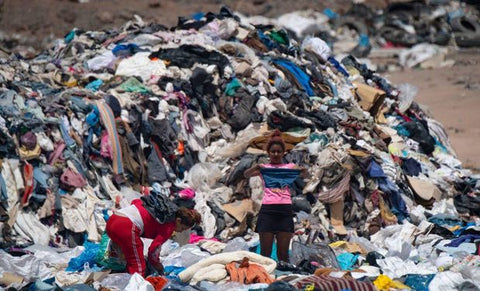
The issue of textile waste: the HOST-approach
Share
In a world where we are confronted with images of deserts filled with discarded clothes, and where an article about Nike secretly shredding 10 000's of new sneakers goes viral on social media, the question rises: where are we really at, with all those good intentions of recycling and circularity programs, promised by different big fashion brands and chains? We can not answer that for you, sadly, but we can share how we approach issues like dead stock and returned items. On a daily basis, we carefully select brands and collaborations to solve this in the most sustainable way.
In the same week, Knack covered that Nike just recently destroyed tens of thousands of shoes in Herentals, both new and worn. This under the guise of their sustainability project Nike Grind, where they promised to collect and recycle worn shoes. As part of the project, Nike said it would separate the materials of the shoes, then process them into granular residual material, which can be used for things like the construction of tennis courts, basketball courts and playgrounds. However, in practice, the parts were not separated at all and returns also ended up in the shredding hall. Talking about mindblowing.
BUT. We do consume. We encourage you to consume too. Our clothes may well have the least possible impact, they are made and they will wear down, eventually. And then there is the issue with dead stock: how small it may be at HOST, we really want to handle that in the most sustainable way. We'd love to share with you a few very cool initiatives that help us deal with all the above.

We love it when our stock can benefit a good cause. We just donated some pieces to the Empty Shop. They will open their doors again, between the 14th and 19th of December. This awesome concept depends on donations by desigers, well-known stylists, fashion enthousiasts, ... The 'emtpy' shop is filled with al these high quality donated clothing, that is then sold in support of a beautiful goal: a first work experience for refugees, as a stepping stone to a new life. So go Empty that Shop! ;-)
Sometimes, our leftover pieces can be turned in a new thing of beauty. We know quite a few designers that work with dead stock or post-consumer fabrics. Take lovely Annelies from Lapland, for example. She creates bags with carefully selected fabrics that she finds in thrift stores, or dead stocks. These pieces are given a second life at Lapland, and the quality, texture and colors of the fabrics determine the idea. That idea is put together by hand, which makes each and every bag unique. Works like charm with old jeans that are returned to us as well! Ofcourse, we are happy to sell Lapland as well! This way, leftover or worn HOST-pieces, sometimes come back... as a brand new item :-)
We LOVE brands that have a true, honest recycling program of their own. We appreciate it all the more from our fair fashion brands, because it takes extra effort and investment, next to all the rest that they do. To name a few: Thinking Mu has been creating their TRASH collection for a few years now, made from old and leftover garments. You can bring your old tights to HOST, and Swedish Stockings will grind them down, to be used as filler material in fibreglass tanks. Our MUD jeans contain up to 40% post-consumer recycled denim. The highest percentage out there.

Last but not least, we are happy to be teaming up with Be The Fibre, a completely circular Belgian brand! All their products are made from fiberized fabrics, originating from non-reusable clothing that is dumped in the well-known clothing containers of Wereld Missie Hulp. By creative and socially responsible entrepeneurship, they want to give something back to society. Not only switching from a linear operation to a circular approach, but all that with a clear vision in mind: employing people in a high-quality manner, marketing circular products and using the proceeds to finance more sustainable development projects. By choosing a Be The Fibre product, you choose to support humanity & our planet. Very proud you can find a selection at HOST!




